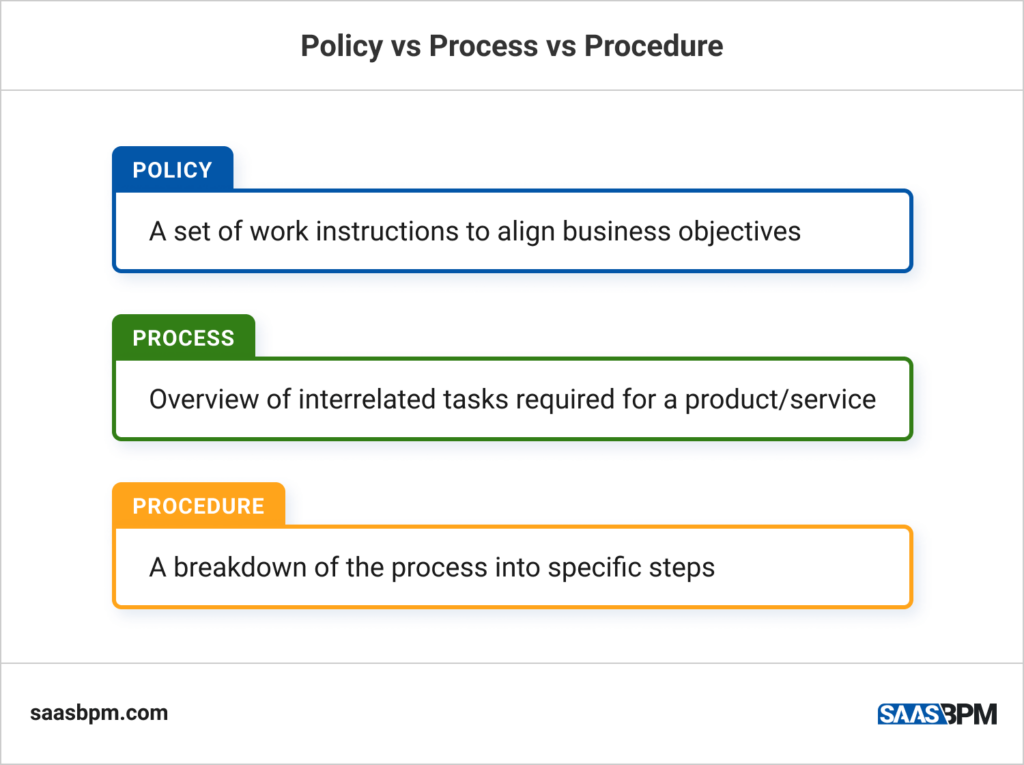In organizational management, the terms policy, process, and procedure often intermingle, leading to potential misunderstandings. Clarity on these concepts is fundamental for seamless governance and operational effectiveness within a business. Policies, processes, and procedures play distinct yet interconnected roles, each contributing to the overall functionality of an organization.
In this article, we will demystify these terms, offering a comprehensive understanding of their individual significance. As we discuss policy creation, the execution of business processes, and the detailed instructions encapsulated in procedures, a clearer perspective emerges on how these elements collectively shape the landscape of effective organizational management.
Without further ado, let’s start unraveling the complexities, as we delve into the purpose, focus, and implementation of policies, processes, and procedures in the dynamic world of business operations.
Policy vs Process vs Procedure: A Quick Overview

To succeed in organizational management, it’s essential to grasp the fundamental distinctions between policy, process, and procedure.
Policies serve as guiding principles, setting the tone for decision-making and shaping the overarching culture of a company. Processes, on the other hand, outline the systematic series of steps designed to achieve specific objectives, contributing to the operational flow of a business. Procedures, the detailed instructions for each step within a process, ensure consistency and precision in execution.
Understanding this triad of policy, process, and procedure is crucial for maintaining organizational order, fostering compliance, and optimizing efficiency. As we embark on unraveling the layers of each element, a clearer picture emerges of how these components work in tandem to propel businesses toward success.
Defining Policy: Purpose, Focus, and Ways To Implement It
In the landscape of organizational governance, policies stand as guiding beacons, shaping the principles and rules that steer decision-making and behavior. The purpose of policies is multifaceted, aiming to establish a framework that aligns actions with organizational objectives, ensures compliance with legal and ethical standards, and fosters a cohesive organizational culture.
The focus of policies extends across various facets, including but not limited to ethics, security, human resources, and operations. An ethics policy, for instance, delineates the moral standards expected from employees, fostering a culture of integrity. Security policies provide guidelines for safeguarding sensitive information, mitigating risks associated with data breaches.
Implementing policies involves a strategic approach. Communication is key, as policies must be clearly articulated and disseminated across the organization. This ensures that employees are aware of the expectations and standards set by the policies. Training programs and workshops play a vital role in educating employees on policy nuances, fostering a culture of compliance and accountability.

Regular reviews and updates are integral to the policy implementation process. As organizational dynamics evolve, policies need to adapt to changing circumstances, industry regulations, and emerging challenges. A dynamic and responsive policy framework ensures that the organization remains agile and resilient in the face of evolving business landscapes.
Moreover, effective policy implementation requires commitment from top-level management. Leadership sets the tone for adherence to policies, influencing organizational culture. By embodying and championing the values outlined in policies, leaders contribute to a culture where policies are not just documents but guiding principles that shape the conduct of individuals at all levels.
What Is A Business Process?
A business process serves as the orchestrated series of activities, tasks, or functions designed to achieve a specific business objective. This is the core of good organizational functionality, providing a structured approach to accomplishing goals. Whether it’s manufacturing a product, delivering a service, or managing internal operations, business processes delineate the systematic flow of activities within an organization.
Each business process typically involves a sequence of steps, and the optimization of these steps is crucial for enhancing efficiency and overall performance. Identifying, analyzing, and streamlining business processes is an ongoing effort in organizations aiming for operational excellence. This involves evaluating the inputs, outputs, and the interplay of various elements within the process.
Making sense of and documenting business processes is instrumental for several reasons. It facilitates a comprehensive view of how work is done, identifies potential areas for improvement, and ensures consistency in operations. Moreover, well-defined business processes empower organizations to adapt to changes, implement best practices, and effectively communicate workflows across teams.
Procedures: Why Do Businesses Need Them?
In the intricate tapestry of organizational operations, procedures play a pivotal role, serving as the detailed instructions that guide the execution of business processes. While processes outline the overarching steps, procedures provide the granular specifics for each step, leaving no room for ambiguity. The question arises: why do businesses need procedures, and what purpose do they serve in the larger context?
First and foremost, procedures are instrumental in ensuring standardisation. They establish a uniform approach to tasks, mitigating the risk of variations in execution. Standardization not only enhances the quality of outputs but also contributes to a consistent customer experience, instilling confidence and trust.
Precision and accuracy are inherent benefits of well-defined procedures. By clearly articulating the steps involved in a process, procedures reduce the likelihood of errors. This is particularly crucial in industries where precision is paramount, such as healthcare, manufacturing, and finance.
Businesses need procedures to enhance accountability. With a clearly documented set of instructions, individuals and teams are accountable for their roles within a process. This accountability fosters a culture of responsibility and ensures that each contributor understands and fulfills their obligations.
Compliance is another critical aspect. Procedures often align with industry regulations and standards. By adhering to these documented processes, businesses demonstrate their commitment to compliance, reducing the risk of legal issues and ensuring ethical conduct.
Moreover, procedures contribute to efficiency. They streamline processes, eliminating unnecessary steps and reducing time and resource wastage. Efficiency, in turn, translates to cost savings and a more agile and competitive business model.
Summary
In conclusion, the policy vs process vs procedure distinctions are essential for effective organizational management. Policies establish overarching principles, steering decision-making and fostering organizational culture. Business processes provide a systematic approach to achieving objectives, while procedures offer detailed instructions, ensuring standardization and precision. Recognizing the unique roles of each element is vital for operational clarity. Policies set the foundation, processes drive functionality, and procedures ensure execution. Together, they form a cohesive framework for governance, accountability, and efficiency, propelling businesses toward success in a dynamic and competitive landscape.

